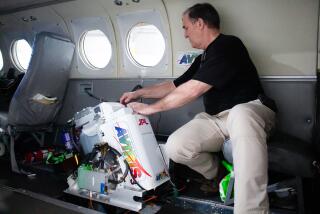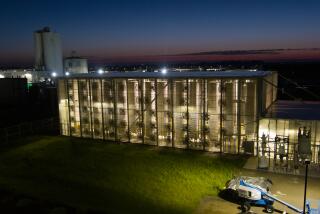Future NASA mission to sun is ‘a life’s dream’ for some
- Share via
The chest-high rack of electronics Justin Kasper is assembling in a Massachusetts office park will fit in a shoe box before he’s done.
It won’t be much to look at — a few inches across, shaped rather like a coffee cup attached to a Kindle — but to Kasper, it’ll serve as eyes across nearly 100 million miles of space.
In less than seven years, that cup will be journeying to the center of the solar system to scoop up bits of the sun.
“This really has been a life’s dream,” said Kasper, of the Harvard-Smithsonian Center for Astrophysics in Cambridge, Mass.
In 2018, NASA is scheduled to launch a spacecraft from Cape Canaveral Air Force Station in Florida to fly, Icarus-like, dangerously close to our star.
Fitted with a select set of instruments, Solar Probe Plus will address two questions that solar physicists have tussled with for decades: How does the corona, that ghostly, spiked halo seen during a total solar eclipse, heat to more than a million degrees, far hotter than the sun’s surface? And what powers the solar wind, the stream of charged particles that flows from the corona?
An up-close look at the sun may ultimately help scientists predict solar flares, as well as coronal mass ejections — “solar storms” like those launched at Earth last week. These events send a barrage of high-energy particles crashing against the Earth’s magnetic field, at times disabling satellites, wiping out power grids, forcing airlines to reroute flights and potentially exposing astronauts to fatal doses of radiation.
Scientists have sent probes to the solar system’s edge, but never so near its heart. Coming within 3.7 million miles of the sun’s surface — 25 times closer than Earth — the 1,350-pound unmanned spacecraft will heat to 2,600 degrees Fahrenheit and endure 512 times the sunlight of vessels orbiting Earth. It is expected to make its first approach from that distance in 2024.
The mission “will undoubtedly have impact on our ideas about how life operates throughout the universe — if life does operate throughout the universe — how our planet evolved and how we’re going to contend with the further exploration of space,” said Richard Fisher, director of NASA’s heliophysics division.
Half a century in the making, with an estimated price tag of $1.2 billion and barely 88 pounds allotted to experimental hardware, the project spawned fierce competition among heliophysicists for a piece of the action.
In September 2010, Kasper learned that his proposal to count the electrons, protons and helium ions in the solar wind had won one of five coveted spots. He happily ripped open boxes filled with commemorative copies of the proposal — he’d let them gather dust for months, afraid to jinx his chances — and passed them out to his team.
Now, with the instruments selected and the project’s next phase underway, some researchers are elated while others tussle with a mix of emotions: sadness at being left out and excitement at what their field stands to learn.
Other spacecraft have ventured toward the sun before: In 1976 the Helios 2 mission came within 27 million miles. The European Space Agency plans to launch a solar orbiter in 2017 that will come as close as 26 million miles.
But Solar Probe Plus, to be built by the Johns Hopkins University Applied Physics Laboratory, is more ambitious by far, venturing seven times closer.
Scientists have talked of such a journey since the 1950s, but plans were always logistically fraught and prohibitively expensive.
They had wanted to study the solar poles because the sun’s magnetic field would be strongest there. But this meant flying over and under the sun rather than girdling its middle like the planets, requiring huge amounts of energy.
The proposed solution: Send the probe to Jupiter, whose gravity would twice lob it back toward the sun, over its north pole and under its south pole.
But sending a probe to such cold, dark reaches of space would require nuclear power — not just solar — and thus a heavy cooling system. Costs mounted.
Time and again, the mission was revived and then shelved.
“Always off again and on again,” said retired solar astrophysicist Eugene Parker. “It came to be a standing joke.”
It was time to rip up the plans and start over.
A thought struck the scientists charged with going back to the drawing board.
“I kept staring at the mission’s scientific objectives, which have been around for a long, long time,” said Andrew Dantzler, who oversaw civilian spaceflight projects at Applied Physics Laboratory until his death in October. “The word ‘polar’ wasn’t in any of the objectives. So I had to go back and ask, ‘Why are we visiting the poles again?’”
That question inspired a totally new idea: Give up on the poles. Swing the craft a few times around Venus and then to the sun, to end up circling its middle.
And everything seemed to fall into place.
Venus is far closer, just 67 million miles from the sun to Jupiter’s 484 million miles. The craft would not need nuclear power. It could be lighter and cheaper. Instead of two flybys, it could make as many as two dozen.
As it turns out, the new mission might be even better, Fisher said.
The craft won’t get as close to the sun as the Jupiter jaunt would have brought it, 1.7 million miles. But it will spend seven times longer (more than 434 hours) within the outer corona, permitting more measurements during different points in the solar cycle and at different places around the sun.
“It’s funny how it all has a domino effect,” Dantzler said.
The unearthly beauty of the corona has long awed eclipse-chasers; its strange properties have long intrigued astrophysicists.
As matter travels away from the sun, one would think it would cool down. Instead, it heats up — from roughly 10,000 degrees Fahrenheit at the solar surface to well over a million degrees in the corona, which extends millions of miles into space.
And rather than slow down, particles speed up, some of them at velocities close to 500 miles per second, fast enough to journey from Los Angeles to New York in about five seconds.
These particles jet from the corona to far past Pluto and wrap back around the solar system, shielding our spot in space from damaging cosmic rays in a protective magnetic “bubble” called the heliosphere.
The probe will need shielding of its own in the ferocious and unpredictable environment near the sun. Superheated plasma zooming along magnetic fields lines, shock waves from the sun’s surface and tiny specks of dust drawn in from the solar system: All will pummel the craft.
The delicate, data-gathering instruments will be sheltered from blinding light and blazing heat by an 8-foot carbon composite shield.
In 2009, NASA issued a call for scientific proposals for the mission. Restrictions were tight. The entire payload would have a weight limit of 40 kilograms (about 88 pounds) and a power budget of 40 watts (“the light bulb inside your refrigerator to run an entire spaceship,” Fisher said).
Out of 13 proposals, four instrument packages were selected.
They will capture samples of the most abundant solar wind particles — low-energy electrons, protons and helium ions — and measure high-energy particles in the solar wind and solar storms. They will map the sun’s electric and magnetic fields; pick up radio and shock waves passing through the plasma; and take detailed, three-dimensional images of the corona.
Scientist Marco Velli of Jet Propulsion Laboratory in La Cañada-Flintridge will run experiments with the instruments — from Earth, of course.
Last week, officials announced that the project had entered the next design phase, and in 2014 the mission team will start to build instruments, assemble the craft and conduct prelaunch tests.
The payload isn’t perfect. There will be no coronal dust detector, which would have helped reveal the composition of dust floating in the corona. More important to some, there will be no instrument to analyze rare, heavy elements in the solar wind, which could have helped show where individual gusts originate.
These shortfalls led some scientists — including some who’d applied for a spot on the mission — to initially criticize the decisions.
“When you wait 30 years for something and spend more than a billion bucks on something, you kind of want it to be right,” said University of Michigan space scientist Lennard Fisk, former associate director of space science and applications at NASA, in an interview last year.
NASA’s Fisher agreed that the mission was “not inclusive.”
“I certainly understand the distress,” he said. “We can’t spend money we don’t have.”
But even those who are disappointed still enthuse about the wealth of insight Solar Probe Plus will bring.
“We’re sad we’re on the sidelines on this one, but that’s what we have to live with,” said Eberhard Moebius, a space scientist at the University of New Hampshire whose experiment didn’t make the cut. “It’s still the most exciting mission in our field.”







